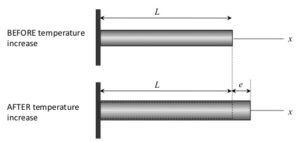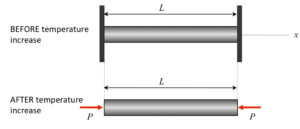Fixed-free rod
A fixed-free rod is heated uniformly by an amount of ΔT. The rod experiences axial and transverse strains due to temperature increase; however, no stress is developed since the right end of the rod is unconstrained.

Fixed-fixed rod
A fixed-free rod experiences the same amount of temperature increase ΔT. Because of the supports, the rod cannot expand and produce an axial strain. Since the physical constraints do not allow for net strains, then 0 = σx/E + αΔT which produces a thermally-induced stress of σx = – EαΔT. Therefore, the rod experience zero axial strain but non-zero stress.

Fixed-fixed rod w/ an initial gap
Consider the fixed-free rod shown below with a gap between its right end and a fixed wall. An initial increase in temperature produces axial strain but no axial stress. As the temperature is increased, the gap closes. Once the gap is closed, the axial strain can no longer increase; however, axial stress is produced. This is shown in the stress animation below. In this animation, the red vertical slider on the left indicates the amount of temperature increase. The blue shading on the rod indicates the level of compressive stress.

